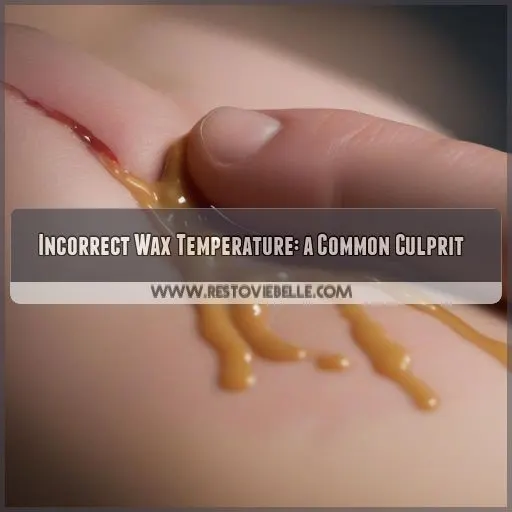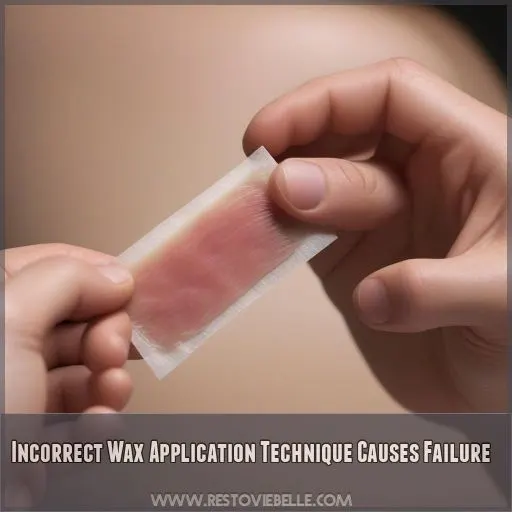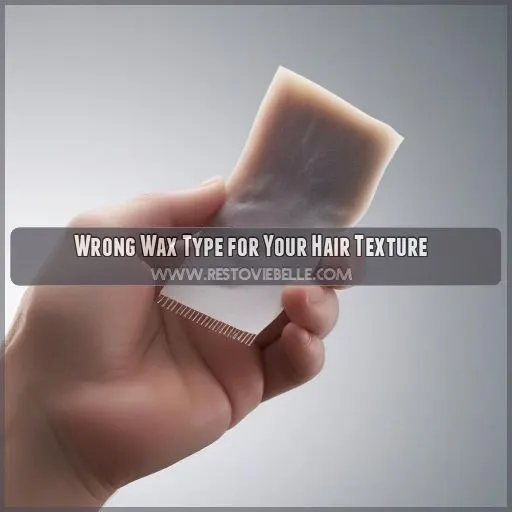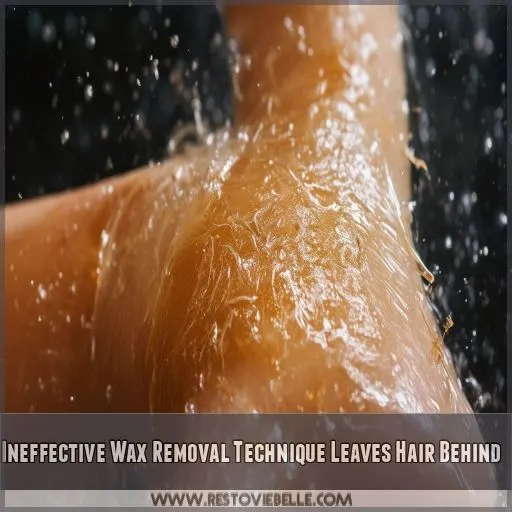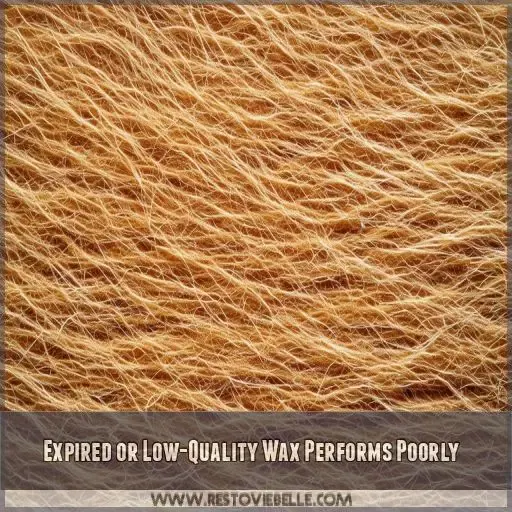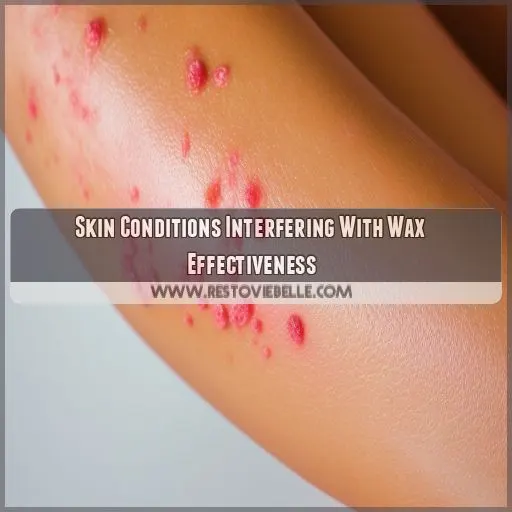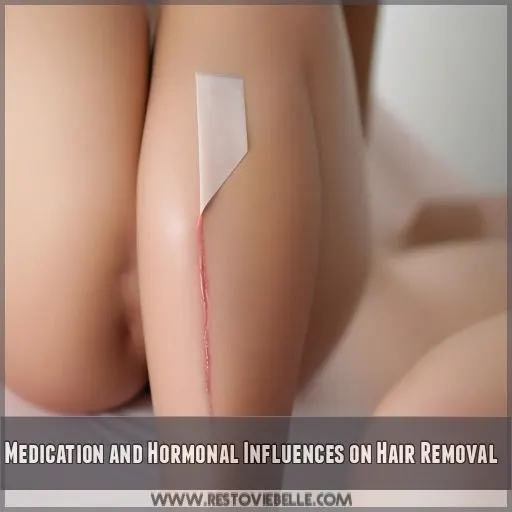This site is supported by our readers. We may earn a commission, at no cost to you, if you purchase through links.
 It could be down to a few things. Make sure you’re applying the wax in the direction of hair growth and removing it swiftly in the opposite direction. If you don’t remove it quickly enough, there might not be enough force to pull the hair out, and it could snap instead.
It could be down to a few things. Make sure you’re applying the wax in the direction of hair growth and removing it swiftly in the opposite direction. If you don’t remove it quickly enough, there might not be enough force to pull the hair out, and it could snap instead.
Wax temperature is also key. If it’s too hot, it’ll smoke and turn runny. If it’s too cool, it’ll be thick and gooey, and not grip your hair.
For more tips on nailing your waxing technique, read on.
Table Of Contents
- Key Takeaways
- Incorrect Wax Temperature: a Common Culprit
- Improper Hair Length Hinders Waxing Success
- Inadequate Skin Preparation Leads to Poor Results
- Incorrect Wax Application Technique Causes Failure
- Wrong Wax Type for Your Hair Texture
- Ineffective Wax Removal Technique Leaves Hair Behind
- Expired or Low-Quality Wax Performs Poorly
- Skin Conditions Interfering With Wax Effectiveness
- Environmental Factors Affecting Wax Performance
- Medication and Hormonal Influences on Hair Removal
- Frequently Asked Questions (FAQs)
- Why is there hair left after waxing?
- Why is my wax not coming out with strip?
- How do you remove stubborn hair wax?
- Why is the wax not coming off my skin?
- How do I remove wax from my skin?
- How long should I wait between waxing and shaving?
- Can I wax my face?
- Why does my skin get irritated after waxing?
- Can I use wax on sensitive areas?
- Conclusion
Key Takeaways
- Wax temperature is key: Too hot or too cold, and it won’t grab hair effectively. Aim for the Goldilocks zone of 110°F to 130°F.
- Hair length matters: Aim for 1/4 inch, like a grain of rice. Too short, and wax can’t grip; too long, and it’s a tangly mess.
- Skin prep is vital: Cleanse and exfoliate for a clean slate. Moisturize dry skin, but not too much, or wax will slip ‘n’ slide.
- Technique tweaks: Apply wax thinly, in the direction of hair growth. Pull strips swiftly, parallel to the skin, and hold skin taut to avoid ouchies.
Incorrect Wax Temperature: a Common Culprit
If your wax isn’t removing hair, the temperature might be to blame. Too hot or too cold, and it’s not gonna do the trick.
Signs of Overheated Wax
You know your wax is overheated if it’s smoking, has a burnt smell, or turns a darker color. The wax might also be too hot if it’s thin and runny, almost watery in texture. If you see any of these signs, let the wax cool down before applying it to your skin.
Consequences of Underheated Wax
If your wax is underheated, it can lead to some frustrating issues. You might notice that the wax:
- Has a thicker, gooier consistency, making it hard to spread evenly.
- Doesn’t grip the hair firmly, resulting in hair breakage instead of smooth removal.
- Leaves behind a sticky residue, making the cleanup process a hassle.
Optimal Temperature Range for Effective Hair Removal
Getting the wax temperature just right is key for a good hair removal experience. Too hot, and you could burn your skin or end up with a sticky mess. Too cold, and the wax won’t grab those pesky hairs. Most waxes work best between 110°F and 130°F. This range means the wax is warm enough to melt and grip the hair, but not so hot that it’s uncomfortable or hard to handle.
Here’s a handy table to guide you:
| Wax Type | Best Temperature Range (°F) |
|---|---|
| Soft Wax | 110°F to 120°F |
| Hard Wax | 120°F to 130°F |
| Peelable Wax | 115°F to 125°F |
Tips for Maintaining Proper Wax Temperature
Getting the wax temperature just right is key for a good hair removal experience. Here are a few tips to help you keep things in check:
- Use a wax warmer to keep the wax at a steady temperature and avoid it getting too hot.
- Give the wax a stir every now and then to make sure the heat is spread evenly and prevent any hot spots.
- Test the temperature before you apply it; it should feel warm, not burning hot, on the inside of your wrist.
Improper Hair Length Hinders Waxing Success
Ever wondered why some hairs just won’t budge, no matter how many times you wax? Well, it might be time to check if your hair length is up to snuff.
If your hair is too short or too long, it can throw a spanner in the works of your waxing routine, leaving you with frustratingly stubborn strands.
Ideal Hair Length for Waxing
Getting the best waxing results starts with the right hair length. You want it to be about 1/4 inch long—think the size of a grain of uncooked rice. This length helps the wax grab onto your hair properly. If your hair is too short, the wax mightn’t be able to catch it, leaving those pesky hairs behind.
| Hair Length | Waxing Success | Action Needed |
|---|---|---|
| 1/4 inch | Ideal | Wax away! |
| Shorter than 1/4 inch | Difficult | Wait for growth |
| Longer than 3/4 inch | Uncomfortable | Trim first |
If your hair is longer than 3/4 inch, it’s time to grab the scissors. Trimming beforehand helps prevent skin issues, bruising, and unnecessary pain during waxing. On the other hand, if your hair is too short, it’s best to wait it out. Allow at least three weeks after shaving or using hair removal creams, and four weeks post-wax, for the best results.
Problems With Too Short Hair
If your hair is too short, the wax may not be able to grip it effectively, leading to disappointing results. Here’s what you need to know:
- Hair needs to be about 1/4 inch long for the best results.
- Shorter hair may not be long enough for the wax to grip.
- Allow enough time for hair to grow to the ideal length before waxing.
- Be patient and resist the urge to wax too soon, as this can lead to frustration and less-than-ideal results.
Issues With Excessively Long Hair
If your hair is too long, it can be a literal pain when waxing. Longer hairs tangle and are more likely to break during waxing, leaving you with uneven results and discomfort. Before waxing, trim hair to about 1/4 inch. This ideal length helps the wax grip the hairs effectively, reducing the risk of breakage and making the process less painful.
Techniques for Trimming Hair Before Waxing
If your hair is too long, you might need to trim it before waxing. Here are some tips for trimming your hair to the right length:
- Use sharp scissors or an electric trimmer designed for body hair trimming.
- Aim for a uniform length of about 1/4 inch, which is roughly the size of a grain of uncooked rice.
- Be careful not to trim it too short, as this can hinder the waxing process.
Inadequate Skin Preparation Leads to Poor Results
You might be wondering why your wax isn’t removing hair effectively, and the answer could lie in how you’re preparing your skin. Let’s explore the importance of skin preparation and how it impacts the overall waxing experience.
Importance of Thorough Cleansing
Dirt and oil are sneaky saboteurs when it comes to waxing. They create a barrier, preventing the wax from gripping each hair effectively. So, before you wax, make sure your skin is spick and span. Use a gentle cleanser and avoid lotions or oils, giving your skin a clean slate for the wax to adhere to.
Exfoliation: Key to Effective Waxing
You know the drill—exfoliation is a must for smooth skin.
It’s the secret weapon to make sure your waxing efforts pay off.
By removing dead skin cells, exfoliation helps the wax grip each hair properly, increasing the chances of successful removal from the root.
It’s like giving your skin a fresh start, making it easier for the wax to do its magic.
Moisture’s Impact on Wax Adherence
Moisture can be a sneaky saboteur when it comes to waxing. Those tiny water droplets can interfere with the wax’s adhesion, leaving you with less-than-desirable results. Here’s how:
- Moisture creates a barrier: Think of it like trying to stick something to a wet surface; it’s just not going to work. Moisture on your skin prevents the wax from properly adhering to the hair, resulting in those stubborn strands staying put.
- Hydrated skin is slippery: Wax needs a grip to effectively remove hair, but moist skin can be too slippery, causing the wax to slide off without grabbing those unwanted hairs.
- Steamy showers are a no-go before waxing: The steam from a hot shower can leave your skin damp, creating the perfect environment for moisture to interfere with your waxing efforts.
- Dry skin is key: Ensuring your skin is completely dry before waxing is essential. Any residual moisture can cause the wax to lose its grip and leave you with patchy results.
Incorrect Wax Application Technique Causes Failure
Are you struggling to get smooth, hair-free skin despite your best waxing efforts? It’s frustrating when the wax doesn’t remove hair effectively, leaving you with stubborn stragglers.
The way you apply the wax plays a big part in successful hair removal. From the direction of application to the thickness of the layer, small mistakes can lead to big problems. Let’s explore the common pitfalls of wax application and how to avoid them.
Direction of Wax Application
Applying wax in the right direction is important for effective hair removal. Here’s the lowdown:
- Always apply wax in the same direction as your hair growth. This helps the wax grip each hair strand at the root.
- When removing the wax strip, swiftly pull it back in the opposite direction of hair growth. This helps remove the hair cleanly from the root.
- Watch the hair growth pattern, as it can vary across different body areas.
Thickness of Applied Wax Layer
Applying wax that’s too thick can lead to irritation and make hair removal a pain. It’s a delicate balance: too much wax increases the risk of irritation, while too little may not grab those stubborn hairs. Go for a thin, even layer, like spreading butter on toast. This helps the wax do its job without causing unnecessary discomfort.
Proper Wax Strip Placement
Getting the wax strip placement right is all about being precise and knowing the right way to do it. Here’s the deal:
- Press the strip firmly and smoothly onto the wax, making sure there are no air bubbles or gaps.
- Apply gentle pressure to make sure it sticks and to stop the strip from moving when you pull it off.
- Place the strip in the direction your hair grows to get the best grip and minimize any ouchies.
- Don’t let strips overlap, as this can lead to uneven pressure and not removing all the hair.
Common Application Mistakes to Avoid
Waxing is all about getting the technique right. Mess up, and you might end up with stubborn hairs or even irritated skin. Here are some common mistakes to avoid:
- Applying wax against the direction of hair growth: Always apply wax in the same direction as your hair grows. This makes sure the hair is caught by the wax for a clean removal.
- Using too much pressure when applying wax: Go easy on the pressure. Pressing too hard can cause bruising or irritation, especially on sensitive areas.
- Forgetting to hold the skin taut: Taut skin is happy skin. Remember to stretch the skin gently before removing the wax strip to minimize discomfort and prevent skin from being pulled.
- Re-waxing the same area multiple times: Once is enough! Waxing the same area repeatedly can irritate your skin and increase the risk of ingrown hairs.
Wrong Wax Type for Your Hair Texture
Are you frustrated with stubborn hairs that refuse to budge despite your best waxing efforts? It’s time to troubleshoot and pinpoint the issue. One common pitfall is using the wrong type of wax for your unique hair texture.
Let’s explore the ins and outs of soft wax versus hard wax, and guide you in selecting the perfect wax formulation for your hair and body areas.
Soft Wax Vs. Hard Wax
Choosing the right wax for your hair texture is important for getting smooth, hairless skin. Let’s look at the differences between soft and hard wax to help you pick the best option for your next waxing session.
| Wax Type | Soft Wax | Hard Wax |
|---|---|---|
| Application | Applied thinly | Applied thickly |
| Hair Type | Effective for fine to medium hair | Ideal for coarse, thick hair |
| Removal | Removed with cloth strips | Removed without strips |
Soft wax is a versatile option, good for different body areas with fine to medium hair. It’s applied thinly and removed with cloth strips, making it a quick and efficient choice. But, soft wax mightn’t be strong enough for coarse hair.
On the other hand, hard wax is made for coarse, thick hair. It’s applied in a thicker layer and removed without needing cloth strips. This makes hard wax a great option for sensitive areas, because it only sticks to the hair and not the skin, which reduces discomfort.
Wax Formulations for Different Body Areas
Different body areas need different wax formulas.
For instance, the wax you use on your legs mightn’t be the best fit for your underarms or bikini area.
This is because hair texture changes across the body, and different wax formulas are made to handle these differences effectively.
Choosing the right wax for the right area gives you the best hair removal results and helps minimize skin irritation.
Matching Wax to Hair Coarseness
You might be using the wrong wax for your hair texture.
Yep, just like Goldilocks, you need to find the wax that’s just right for your hair coarseness.
If your hair is coarse and thick, go for hard wax. It’s like a knight in shining armor, gripping each hair firmly for removal.
Soft wax can still remove coarse hair, but it needs to be strong enough – think superhero status.
For soft wax, apply it thinly like a stealthy ninja to avoid using too much product.
Specialized Waxes for Sensitive Skin
If you have sensitive skin, choosing the right wax is really important to avoid irritation. Opt for specialized waxes designed for sensitive skin, which often contain soothing and nourishing ingredients like aloe vera or chamomile. These waxes are formulated to minimize discomfort and reduce the risk of redness or inflammation.
It’s also important to think about the area of the body being waxed. Different body parts have varying levels of sensitivity, so choose a wax suitable for that specific area. For example, the bikini area is more sensitive than the legs, so you might select a wax designed for sensitive skin in that region.
Ineffective Wax Removal Technique Leaves Hair Behind
Even if you’ve got the right wax and hair length, an ineffective wax removal technique can leave hair behind. We’ll show you how to perfect your technique so you get a clean wax every time.
Correct Angle for Wax Strip Removal
When removing the wax strip, it’s important to hold your skin taut. Pull the strip off quickly and parallel to the skin, in the opposite direction of hair growth. Avoid pulling up to prevent bruising or tearing the skin. You should also avoid a 90° angle; instead, opt for a more shallow angle.
To make sure the wax strip stays strong and intact during removal, Liz Lugo recommends lifting the lip and then folding it over. This technique helps to ensure a clean removal and prevents hair breakage.
Speed and Force in Wax Removal
Speed and force are key when you’re waxing. Yank that strip off too slowly and you’ll risk breaking hairs instead of removing them from the root. But go too fast and you might bruise yourself or irritate your skin. It’s all about finding that Goldilocks zone—not too fast, not too slow. Just right.
So, how fast is fast enough? Well, think of it like this: a quick, confident pull will do the trick. No need to rush, but a swift motion will help those hairs come out cleanly.
As for force, a gentle touch is best. You don’t need to press too hard on the skin; just hold it taut and pull with a firm, even pressure.
Importance of Skin Tautness During Removal
Holding your skin taut during waxing is really important for effective hair removal and minimizing discomfort.
Without proper skin tautness, you risk the wax pulling at your skin instead of just the hair, which can be painful and cause bruising or irritation.
It’s important to stretch the skin tight before applying the wax and to keep this tension as you swiftly remove the strip in the opposite direction of hair growth.
This technique makes sure the hair is removed from the root, leaving your skin smooth and minimizing the risk of ingrown hairs.
Dealing With Partially Removed Wax
If you’re left with partially removed wax, don’t panic.
First, make sure you hold the skin taut to minimize discomfort and prevent skin from being pulled.
Then, gently remove the remaining wax with a clean paper strip or by twisting the hair between your fingers.
For delicate areas, like eyebrows, apply oil and gently brush with a brow brush until the wax is gone.
A little talc can also help remove any stubborn residue.
Expired or Low-Quality Wax Performs Poorly
If your wax isn’t removing hair effectively, the problem could be with the wax itself. Expired or low-quality wax simply won’t perform as well as fresh, high-quality wax.
In this section, we’ll explore the signs of expired wax, the impact of wax quality on hair removal, and proper storage techniques to keep your wax in good shape.
Signs of Expired Wax
Expired or low-quality wax can lead to less-than-desirable results. Here are some signs that your wax may be past its prime:
- Changes in Color: If your wax has discolored or developed a yellowish tint, it’s likely expired. Fresh wax typically has a creamy, consistent color.
- Odd Texture: Expired wax can become hard, lumpy, or difficult to spread smoothly. It may also feel sticky or tacky, indicating a breakdown in its chemical composition.
- Strange Consistency: Over time, wax can separate, with liquid forming at the top or bottom of the container. This is a sure sign that the wax is no longer effective and needs to be replaced.
Impact of Wax Quality on Results
The quality of your wax directly impacts your waxing results. Expired wax loses its effectiveness over time, just like stale bread that can’t make a decent sandwich. Low-quality wax is like buying cheap tools—it might work once or twice, but it won’t last and will likely give you trouble.
Proper Wax Storage Techniques
Storing your wax right is key to keeping it working well. Here are some tips to help your wax stay in tip-top shape:
- Keep it cool and dry: Store your wax in a cool, dry place, like a cupboard or drawer. Avoid places with big temperature swings, like the bathroom, where humidity and temperature changes can mess with the wax’s consistency.
- Use airtight containers: Put your wax in airtight containers to stop it from getting contaminated and to keep it fresh.
- Label and date: Always label your wax containers with the date you bought it or opened it. This helps you keep track of how long the wax will last and makes sure you use it before it’s too old.
- Stock up on high-quality wax: Invest in brands that are known for good wax quality. It might be tempting to go for cheaper options, but low-quality wax mightn’t work as well and could lead to frustration during your waxing sessions.
Skin Conditions Interfering With Wax Effectiveness
Your skin’s condition can impact how well waxing works. Whether it’s oily, dry, or sensitive, your skin’s unique traits can either help or hinder the process. Let’s explore how to handle these challenges and get smooth, effective hair removal.
Impact of Oily Skin on Waxing
If you have oily skin, you might feel like your wax isn’t grabbing those hairs effectively. That’s because oil can create a barrier, preventing the wax from adhering properly to your hair. But don’t worry, there are some simple solutions!
| Pre-Waxing Routine | Post-Waxing Routine |
|---|---|
| Cleanse your skin with an oil-free cleanser | Exfoliate regularly to keep pores clear |
| Avoid using lotions or oils before waxing | Apply a soothing, oil-free lotion to calm the skin |
| Use a gentle scrub to exfoliate and remove excess oil | Avoid hot showers and sun exposure for 24 hours |
Dry Skin and Waxing Challenges
Dry skin can also mess with how well waxing works. Here are some things you might run into and how to deal with them:
- Moisturize: Dry skin can make wax stick harder, which hurts when you pull it off. Keep your skin hydrated by moisturizing regularly.
- Exfoliate: Get rid of any flaky skin by exfoliating a few days before waxing. This makes the wax grip the hair better.
- Hydrate: Drink lots of water to keep your skin hydrated from the inside out. This helps make sure your skin is in good shape for waxing.
- Avoid Over-Exfoliation: Exfoliating is important, but don’t go overboard. Too much exfoliating can irritate your skin, making it more sensitive and prone to getting inflamed.
Skin Sensitivities and Waxing Precautions
If you have sensitive skin, waxing can be a tricky business. You might be dealing with skin sensitivities if your skin reacts to waxing with redness, irritation, or even breakouts. Here are some waxing precautions to keep in mind:
- Always do a patch test before waxing, especially if you’re using a new product or have sensitive skin.
- Choose waxes designed for sensitive skin, which are often infused with calming ingredients.
- Avoid waxing if your skin is already irritated, inflamed, or sunburnt.
- Exfoliate regularly to prevent ingrown hairs, but be gentle on sensitive skin.
- Consult a dermatologist if you have persistent skin reactions to waxing.
Managing Skin Conditions for Successful Waxing
It’s not just about the wax and technique; your skin’s condition also plays a pivotal role in the effectiveness of hair removal. Here’s how to manage common skin concerns for a smoother waxing experience:
- Oily skin: Make sure your skin is thoroughly cleansed before waxing. Oil can prevent the wax from gripping hairs, so double-cleanse if needed to make sure your skin is free of excess sebum.
- Dry skin: Moisture is key. Make sure your skin is well-hydrated, as this helps the wax adhere better. Exfoliate regularly to remove dry, flaky skin that can interfere with wax effectiveness.
Environmental Factors Affecting Wax Performance
Even the most experienced waxers can be thrown off their game by something as simple as the weather. Yes, environmental factors like humidity and temperature fluctuations can affect how well your wax performs, and that’s why it’s important to have a controlled waxing environment.
Humidity’s Effect on Wax Consistency
Environmental factors, like humidity, can impact your waxing experience. Humidity affects the consistency of wax, making it sticky and challenging to work with. This can lead to a messy situation and less-than-stellar hair removal results.
The moisture in the air can cause the wax to become tacky and difficult to manage, resulting in a gooey mess that’s hard to remove.
Temperature Fluctuations and Wax Behavior
You’re all set to wax, but the temperature’s a bit wonky and your wax just isn’t cooperating. Here’s the lowdown on why temperature fluctuations mess with your wax’s performance:
- Wax consistency is key: Too hot and it’s a mess, too cold and it’s stubbornly solid.
- Optimal temperature range: Aim for that sweet spot where your wax is just right.
- Environmental factors: Room temperature and humidity play a part. No extremes, and avoid drafts.
- Troubleshooting: If your wax is acting up, check the temp and adjust. Use a thermometer for precision.
Importance of a Controlled Waxing Environment
The environment you wax in matters. It’s not just about the wax itself or your technique; external factors like cleanliness, hygiene, safety, temperature, and ventilation play a huge role in successful hair removal.
A controlled environment helps the wax work properly. You don’t want dust, dirt, or grime messing with the wax’s ability to grip and remove hair. Keep the area well-ventilated to avoid stuffiness and keep a comfortable temperature.
It’s like baking a cake. You need the right ingredients, skills, and environment (a clean kitchen, steady oven temperature) for the cake to rise and taste delicious. Same with waxing—create the right conditions for the best results.
Adapting Waxing Techniques to Environmental Conditions
Environmental factors can impact your waxing results.
These factors include humidity, temperature, climate, seasons, and location.
For instance, high humidity can affect the wax’s consistency, making it too soft to grip hairs effectively.
On the other hand, dry climates can cause wax to become brittle and hard to apply smoothly.
Adjust your waxing technique by controlling the room temperature and humidity to create a good environment for wax performance.
Medication and Hormonal Influences on Hair Removal
Medication and hormonal changes can impact hair growth patterns and waxing effectiveness. This section will help you understand how to adapt your waxing routine to these bodily changes and when to seek professional advice.
Medications Affecting Hair Growth Patterns
Certain medications can impact hair growth patterns, leading to unexpected waxing outcomes. If you’re taking meds, they might be affecting your hair’s growth cycle, making it harder for wax to grip and remove hairs effectively. Consult a doctor or dermatologist if you’re concerned about medication-related hair growth changes and their impact on waxing results.
Hormonal Changes Impact on Waxing Effectiveness
Hormonal fluctuations can impact how well waxing works for you. These changes are often due to medication or natural shifts in your body’s chemistry, like menopause. Hormones play a role in hair growth, so it’s no surprise they can affect the effectiveness of waxing. If you’re experiencing these issues, it’s worth consulting a professional to adapt your routine.
Adapting Waxing Routines to Bodily Changes
Our bodies are ever-changing, and that includes our skin and hair. As we go through life, we might find that our once-reliable waxing routine needs an upgrade. This could be due to:
- Pregnancy
- Menopause
- Aging
- Medication
Each of these factors can influence hormone levels, which in turn affects hair growth patterns and skin sensitivity. As a result, you might need to adapt your waxing routine to keep up with these changes.
When to Seek Professional Advice
If you’re experiencing persistent skin issues like ingrown hairs, irritation, or infections, consult a dermatologist for guidance. They can provide expert advice on managing these concerns.
Additionally, certain medications and hormonal changes can impact hair growth and skin sensitivity. If you’re undergoing medical treatment or noticing hormonal shifts, chat with your healthcare provider before waxing. They’ll advise on any adjustments needed for safe and effective hair removal.
Frequently Asked Questions (FAQs)
Why is there hair left after waxing?
Oh, the dreaded leftover hair! It’s like finding a spider in the bath or realising your ‘cashmere’ jumper is actually acrylic. Here’s the lowdown: hair left behind means your wax isn’t gripping properly.
Why is my wax not coming out with strip?
There are a few reasons why your wax mightn’t be coming out with the strip. You could be applying the wax too thickly, not holding your skin taut enough, or pulling the strip too slowly.
How do you remove stubborn hair wax?
You’re frustrated with stubborn hair wax that just won’t budge. Like a bad relationship, it’s time to break free. Cool the wax with a damp cotton pad, then apply talc to set it. Now, you’re back in control.
Why is the wax not coming off my skin?
There are a few reasons why wax mightn’t be coming off your skin. It could be that the wax is too cold, or that you’re not pulling the strip quickly enough.
How do I remove wax from my skin?
To remove wax from your skin, try oil or talcum powder. For accidental drips, wipe with oil or twist the hair to remove the wax.
How long should I wait between waxing and shaving?
You should wait around three weeks after shaving before you wax, and then five weeks after waxing before you shave again.
Can I wax my face?
Yes, you can wax your face, but it’s best left to the professionals. Facial skin is more sensitive, thinner, and oilier than the rest of your body, so it’s tricky to get right.
Why does my skin get irritated after waxing?
There are a few reasons why your skin might get irritated after waxing. It could be due to sensitive skin, improper waxing technique, or not taking the necessary precautions before and after waxing. To avoid irritation, make sure you’re using the right products, prepping your skin properly, and following the correct waxing technique. Consult a professional if issues persist.
Can I use wax on sensitive areas?
Yes, you can wax sensitive areas like the face, bikini area, underarms, and eyebrows. But proceed with caution. Start with a patch test on less sensitive areas like the legs, arms, or toes. Use hypoallergenic waxes to prevent allergic reactions.
Conclusion
There are a multitude of reasons why your wax mightn’t be removing hair effectively.
From incorrect wax temperatures and improper hair length, to skin conditions and environmental factors, each issue presents a unique challenge.
By understanding these common pitfalls and learning how to optimize your waxing technique, you’ll be well on your way to smoother skin.
